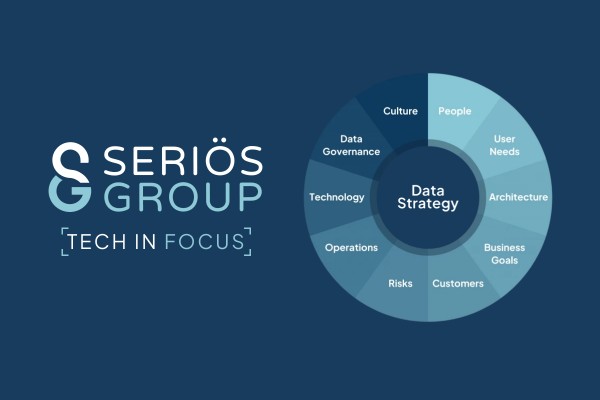Insights
5 Steps to Building Your Data Strategy

- Category
- Blog
- Date published
- 13.05.2025
- Written by
- Adam Brown, Head of Data Strategy and Architecture at Seriös Group
A strong data strategy has many moving parts: vision, governance, people, technology, culture, architecture, operations and change. There is a lot to think about, so where do you start?
Here are the five steps we would recommend taking. Each one builds on the last, helping you move from strategic intent to practical delivery.
Step 1. Align your Data Strategy with business goals
Your data strategy shouldn’t exist in a vacuum. Its starting point must be the broader strategic vision of the organisation. Why? Because the value of data only emerges when it’s connected to real organisational priorities.
Too often, data strategies are written as if the business strategy doesn’t exist, focusing on tools, platforms, and pipelines without ever asking: “What are we trying to achieve as a business?”.
By tightly aligning your data strategy with your organisation’s goals, whether that’s growth, innovation, customer experience or efficiency, you give data a clear purpose and direction. It also makes it much easier to justify investment and prioritise initiatives.
Without that alignment, data efforts risk becoming expensive side projects rather than business accelerators.
Step 2. Understand and prioritise user needs
A data strategy that reflects real user needs is far more likely to gain traction and deliver meaningful impact. But this isn’t about gathering a long wish list of nice-to-haves. It’s about understanding what people across the business are trying to achieve, what’s blocking them and how better data could help progress.
To make user needs meaningful, they should be documented with three key elements:
- The problem – What’s the user trying to achieve and what is holding them back?
- The impact – What would change if this problem were solved? Think in terms of time saved, decisions improved, efficiency gained, or risk avoided.
- The strategic link – How does this connect to broader business goals? What part of the company’s strategic plan does it support?
This approach uncovers pain points and highlights where bottom-up demand aligns with top-down priorities. This is the sweet spot where your data strategy can make the biggest impact. By grounding user needs in business context, you move from individual frustrations to shared value.
Step 3. Build a practical data governance strategy
Data governance isn’t optional; it’s the foundation for everything else. If people don’t trust the data, don’t know who owns it, or can’t access it when they need to, the best strategy in the world will fall flat.
Your data governance strategy should outline:
- Ownership and stewardship roles
- Quality controls and standards
- Access and security protocols
- Metadata and cataloguing
Most importantly, governance should be positioned as an enabler, not a blocker. It’s about making data safer, faster and more useful.
Step 4. Plan for risks and roadblocks
It might not sound glamorous, but this is one of the most practical things you can include. Every data strategy will face roadblocks, from skill shortages and legacy systems to culture clashes and shifting priorities. Identifying known risks and issues (and who’s accountable for managing them) builds realism into your strategy and helps stakeholders take ownership.
It also shows maturity. You’re not pretending it’ll all be smooth sailing; you’re planning for turbulence.
Step 5. A flexible 3-year plan
A strategy is just theory until it’s translated into a plan. A flexible three-year roadmap gives your data strategy credibility. It shows the sequence of initiatives, key transitions and high-level timelines. Crucially, it should include room for iteration, the ability to adapt as you learn, as priorities shift, or as new technologies emerge. This balance of direction and adaptability is what separates shelfware strategies from those that drive real change.
But before you start, we’d recommend a data maturity assessment.
Benchmark with a Data Maturity Assessment
A data maturity assessment gives you a starting point, a benchmark of where your organisation is today in terms of data capabilities, behaviours and infrastructure. It also provides a baseline for tracking progress over time.
Even a lightweight self-assessment can guide investment, reveal gaps and set realistic expectations.
A Powerful Strategy
There’s no perfect formula for a data strategy. Every organisation is different, and your strategy should reflect your vision, culture and stage of maturity.
These five steps are a solid place to start. Because a strategy aligned to business goals, centred on users, underpinned by governance, aware of risks and backed by a flexible plan? It's a strong foundation for a data strategy that actually works, rooted in real business needs, not just theory.
Need help building a Data Strategy?
Whether you're starting from scratch or refining what’s already in place, we help organisations shape strategies that are clear, practical and deliver.





